It has been proven that the keys to a healthy life are exercise, positive outlook, and healthy diet. Among these, eating healthy might just be the trickiest of all. Thanks to an enterprising food industry that conjures all the confusing foodstuffs in the market today.
You might think that eating healthy is like coloring by numbers, just eat what says “low fat”, “gluten-free”, “high fiber”, “multigrain” and “natural” and you’re all set to tread the path to a healthy life. Even the most health-conscious and sophisticated consumers are misled by these labels into thinking that they’re purchasing healthful products.
So, what “healthy” food must you avoid to ACTUALLY eat healthy?
Reduced-fat, low-fat, non-fat, diet, lite, light…you get the idea
Not all fat-free or reduced-fat products are healthier than their full-fat counterparts. Sometimes, they’re even worse. According to a UK study, 10% of diet foods have the same, if not more, calories than their regular counterparts, and 40% also had more sugar. When fat is removed, more sugar is added to compensate for the bland taste. Additionally, fat makes you full, so when all fat is removed, you feel less satiated and tend to consume more empty calories than you bargained for.
Enhanced water, flavored water, vitamin water, sodas
The best beverage is water, zero calories, no fuss. Water that is enhanced with artificial flavorings, artificial colors, and additional vitamins and minerals are more often than not also way too sugary. Not only are you downing sugared water but also taking unnecessary additives. Also, if you are already eating a nutritious meal and/or taking supplements, those additional vitamins and minerals may do more harm than good. If you really want flavored water, infuse your plain water with farm fresh fruits and herbs of your choice.
Pre-prepared, pre-packaged, instant foods
Not all pre-prepared and pre-packaged foods are unhealthy. To be sure, check the ingredients list. Although fast and convenient, pre-prepared foods are usually loaded with sodium, preservatives, flavor-enhancers, ingredients only a chemist would understand, and a whole bunch other things you’re not sure where they got from. These are in there to prolong shelf-life and keep the flavor. Read the ingredients list and if there are too much ingredients you haven’t heard of, put it back in the shelf. You wouldn’t want to put something you don’t know in your body, would you?
Multigrain, refined, enriched food products
Multigrain breads, crackers, cereals and pasta often cause a lot of confusion for consumers. Food buyers see “multigrain” and think “whole grain.” That’s what food manufacturers want us to think but that’s not what it really is. When you see “enriched wheat flour” in the ingredient list, that’s actually refined flour which studies have already proven as less healthy than whole grain. Ensure that a whole grain, (whole wheat, whole oats, whole rye or brown rice) is the only grain in the ingredient list.
Store bought commercial fruits and vegetables
Shocking? According to Les Mills Nutrition, Fruits and vegetables in supermarkets could hit the store up to three weeks since they have been harvested. So, by the time you get them to your dining table, their nutritive content have already significantly depleted. Eat “fresh” fruits and vegetables. It’s best to source your fruits and vegetables from the farm or the farmers market. Go organic and arrange for a weekly delivery from a trusted supplier to ensure that you’re getting nothing short of farm-fresh.
If you can, it’s still better to prepare your food from scratch to ensure that you are using unadulterated ingredients. But if convenience is a factor, at least make it a habit to read the entire ingredients list AND the nutrition facts, you’ll be surprised at what you’ll find.
Image Source; Image Source; Image Source






